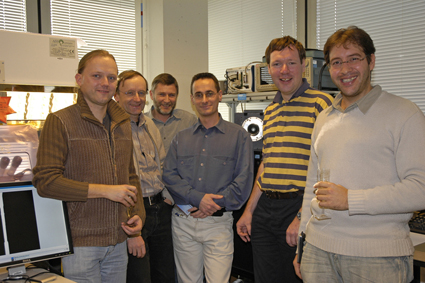- Home
- News
- General News
- From a large hornet...
From a large hornet to a speedy camera
15-01-2007
ESRF sells a fast readout camera for the first time - For the French, a "frelon" is the largest European wasp that is attracted to light. In the X-ray community, a FReLoN is the acronym for the Fast Readout Low Noise camera, a detector also attracted to light, but this time, synchrotron light. This camera is built and used at the ESRF beamlines and was sold for the first time last December to another light source, ANKA, in Germany.
Share
An image is made up of varying tones of black and white. A commercial digital camera today has about 1000 shades of grey which refer to the different intensities that change from black to white. The FReLoN camera, as well as other scientific cameras, multiplies these shades by twenty. However, it is its speed that makes the difference between this camera, conceived and built at the ESRF, and those built by industry but also used for scientific purposes.
Today, the camera reads 16 images of 1000x1000 pixels per second. However, this has not always been the case. In the early days, about a decade ago, the state-of-the-art camera needed 20 seconds to read one single image. “The time-resolved aspect of this machine is its most valuable asset”, explains Jean-Claude Labiche, engineer and “father” of the FReLoN.
This high performance has encouraged staff at the German synchrotron ANKA to buy a FReLoN camera from the ESRF. It will be used at a new imaging beamline in the German facility. Timm Weitkamp, former scientist at the ESRF and currently at ANKA, explains that “there is nothing on the market like this, it is a unique device and we are very happy to have it”.
Despite the camera’s success and the fact that one has already been sold, this invention has not been patented. Labiche argues that the ESRF is a non-profit organisation and patenting would involve a commercial aim (ANKA only paid the cost-price).
 |
|
The FReLoN team. From left to right: Timm Weitkamp (ANKA), Jean-Claude Labiche, Daniel Pothin, Laurent Siron, Emmanuel Collet and Alejandro Homs. Missing in the photo: Jean-Jacques Thevenan. |
He claims that the value of the machine is the human know-how of the team working on it. This includes the four people involved in the development of the camera itself plus partially other groups at the ESRF, such us the mechanical engineering group or the Beamline Instrument Software Support Group (BLISS). Especially close is the relationship with the latter, which assures the complex interface between the detector and the data acquisition. After all, the FReLoN is one of the elements that make up the beamline and must be smoothly integrated into the whole structure.
 |
|
The study of frogs’ muscles, powder or collagen fibres are some examples of research using FReLoN cameras. In fact, this detector is so well established at the ESRF that it is cited in 170 publications since 1997. This series of images is a typical example of time-resolved small-angle diffraction pattern from live muscle depicting different states, resting, at the plateau of isometric contraction and released to nearly zero force by shortening the muscle. These diffraction diagrams permit to follow conformational changes in the force generating myosin motor proteins during different muscle states (Images are courtesy of J. Bordas). |
At the moment there are ten beamlines continually using FReLoN cameras, whilst others use them sporadically. The interaction with the scientists helps the FReLoN team identify the needs of the community and enhances the product, pushing limits and inventing new ideas for experiments, like for example, the time resolved experiments in chemistry on ID24 or diffraction on ID11.
The machines that Labiche and his team currently produce are the third generation of a detector that was first built in 1995. “We have improved the product a lot since the beginning”, he asserts, stressing that “It has become more versatile and user friendly”. The project for this year is to build six new cameras for ESRF and Collaborating Research Groups (CRG) scientists to produce even faster and more accurate cameras. Many synchrotron sources have expressed their interest in acquiring a FReLoN. Progress also continues at full speed.



